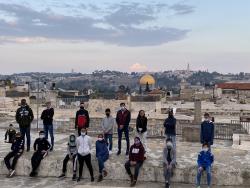
This project worked in collaboration with the Al-Saraya Centre for Community Service to gather children together from Jerusalem and its surrounding areas with the objective of teaching them about the history of Jerusalem's Old City. Al Saraya Center networked with community organizations such as Al Bustan Center (from Silwan), Al Ansar Club (Wadi Kadeem), Shomoo’ Al Quds (Altur), Silwan Women Center (Silwan), allowing for diversification and for children from different neighbourhoods to interact with each other. Thirteen field trips were organized, covering different Mamluk sites such as the Al Tashtamariyyeh School, the Jawhariyyeh School, the Mazhariyyeh School, the Argoniyyeh School and the Ribat Al Kurd. Marwa, a young girl from the Old City of Jerusalem, recounted: "I felt embarrassed a little bit when the girls from Silwan were asking me about some markets or khans; they assumed I knew because I live in the Old City. But I didn’t know! Some places that I pass by everyday were becoming a routine scene, so I never questioned what they were or what the history behind them is. Now I know the whole story about the Mamluk and their heritage in Jerusalem!"
Following the field trips, photography courses took place. These were made up of five three hour sessions, and included basic photography techniques, mobile photography, the concept of light and angles and both indoor and outdoor photography. The children then were asked to implement what they learnt and took pictures based on the knowledge and skills explained and acquired. Similarly, the centre held drawing courses for the students as well, where they learnt important skills such as drawing with a pencil, shadows and light, angles of drawing, drawing with pastel colors, how to mix and match colors, and the division of paper space. These activities served as a debriefing tool and not only as a course to learn a new skill, but as a significant bonding tool both amongst children as well as with social workers and mentors at the centre. After the conclusion of these courses, both a drawing and a photography competition were held, where eighteen winners were awarded the prize of 50 USD each.
Overall, this project was immensely successful in that it involved many children and encouraged them to interact, an instance made all the more valuable given the isolation children experienced during the Covid-19 pandemic. They learned a great amount and increased their knowledge of Mamluk history and architecture, as well as gaining new drawing and photography skills that many continued to pursue after this introduction.
